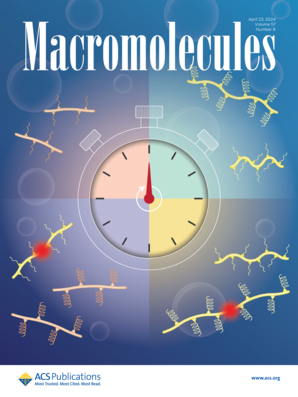Crosslink Dynamics Control Injection Force and Flow Profiles of Non-Covalent Gels
IF 5.1
1区 化学
Q1 POLYMER SCIENCE
引用次数: 0
Abstract
Dynamically cross-linked hydrogels have found remarkable utility in 3D bioprinting and injectable slow-release delivery of pharmaceutics and vaccines, applications which take advantage of their ability to flow through needles or extrusion devices with relative ease. Predicting the force required to inject or extrude dynamic hydrogel materials is paramount to their application. Here, we report an injectable dynamic hydrogel with facile tunability of the cross-link exchange rate using a small-molecule surfactant. We found surprising nonmonotonic trends in injection force with respect to cross-link dynamics, not explained by traditional flow rheology measurements. By using an optical in situ capillary rheometer, we found that wall slip is the dominant mechanism influencing flow profiles, rather than shear banding, as has been reported in previous studies of dynamically cross-linked hydrogels. We hypothesize that the main driver of flow rheology and injection force for these materials is the combination of a lower slip distance and bulk stiffness with increasing dynamicity, balancing the bulk cohesive force with adhesive forces to the wall. Finally, by developing new models which describe the flow behavior of noncovalent gels, we present new criteria for extrudability, enabling better predictions for operating conditions of downstream applications of dynamic hydrogels.

交联动力学控制非共价凝胶的注入力和流动特征
动态交联水凝胶在3D生物打印和药物和疫苗的可注射缓释递送中发现了显著的实用性,这些应用利用了它们相对容易通过针头或挤出设备的能力。预测注入或挤出动态水凝胶材料所需的力对其应用至关重要。在这里,我们报告了一种可注射的动态水凝胶,其交联交换速率易于调节,使用小分子表面活性剂。在交联动力学方面,我们发现了令人惊讶的注入力非单调趋势,这是传统流动流变学测量无法解释的。通过使用光学原位毛细管流变仪,我们发现壁面滑移是影响流动剖面的主要机制,而不是剪切带,正如之前对动态交联水凝胶的研究所报道的那样。我们假设,这些材料的流动流变性和注射力的主要驱动因素是较低的滑移距离和体刚度与增加的动力的结合,平衡了体粘结力和对壁面的粘附力。最后,通过开发描述非共价凝胶流动行为的新模型,我们提出了可挤压性的新标准,从而更好地预测动态水凝胶下游应用的操作条件。
本文章由计算机程序翻译,如有差异,请以英文原文为准。
求助全文
约1分钟内获得全文
求助全文
来源期刊

Macromolecules
工程技术-高分子科学
CiteScore
9.30
自引率
16.40%
发文量
942
审稿时长
2 months
期刊介绍:
Macromolecules publishes original, fundamental, and impactful research on all aspects of polymer science. Topics of interest include synthesis (e.g., controlled polymerizations, polymerization catalysis, post polymerization modification, new monomer structures and polymer architectures, and polymerization mechanisms/kinetics analysis); phase behavior, thermodynamics, dynamic, and ordering/disordering phenomena (e.g., self-assembly, gelation, crystallization, solution/melt/solid-state characteristics); structure and properties (e.g., mechanical and rheological properties, surface/interfacial characteristics, electronic and transport properties); new state of the art characterization (e.g., spectroscopy, scattering, microscopy, rheology), simulation (e.g., Monte Carlo, molecular dynamics, multi-scale/coarse-grained modeling), and theoretical methods. Renewable/sustainable polymers, polymer networks, responsive polymers, electro-, magneto- and opto-active macromolecules, inorganic polymers, charge-transporting polymers (ion-containing, semiconducting, and conducting), nanostructured polymers, and polymer composites are also of interest. Typical papers published in Macromolecules showcase important and innovative concepts, experimental methods/observations, and theoretical/computational approaches that demonstrate a fundamental advance in the understanding of polymers.
 求助内容:
求助内容: 应助结果提醒方式:
应助结果提醒方式:


